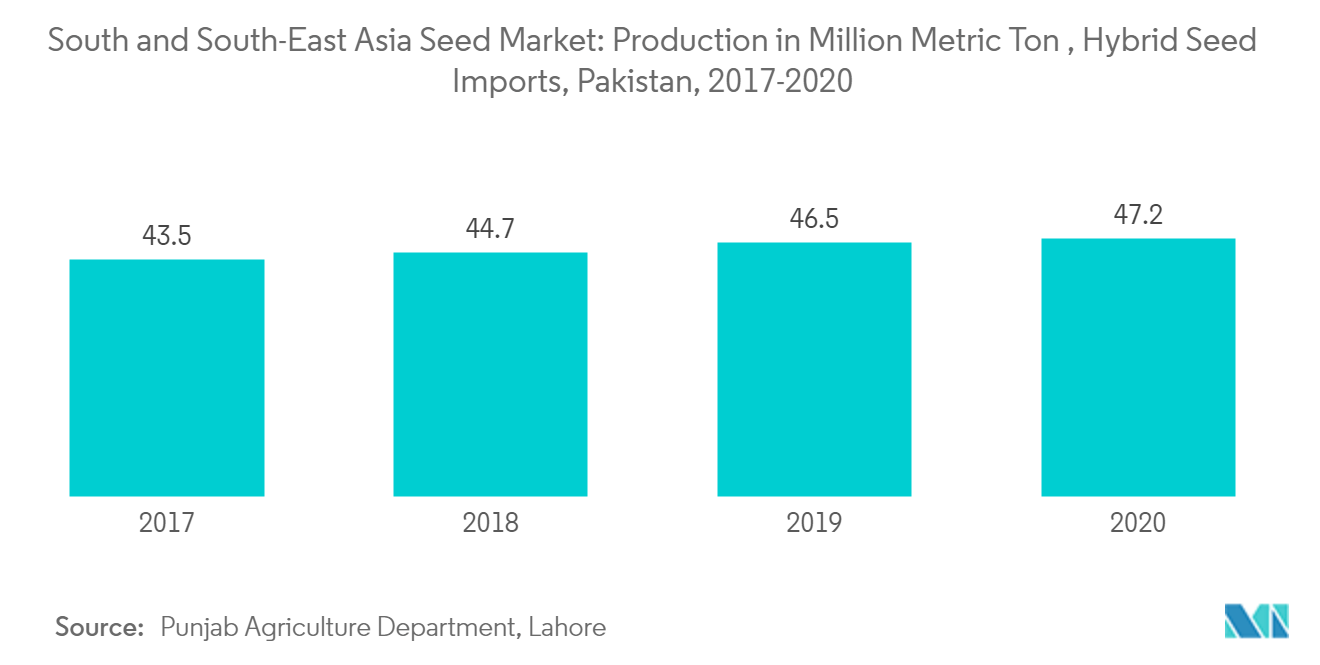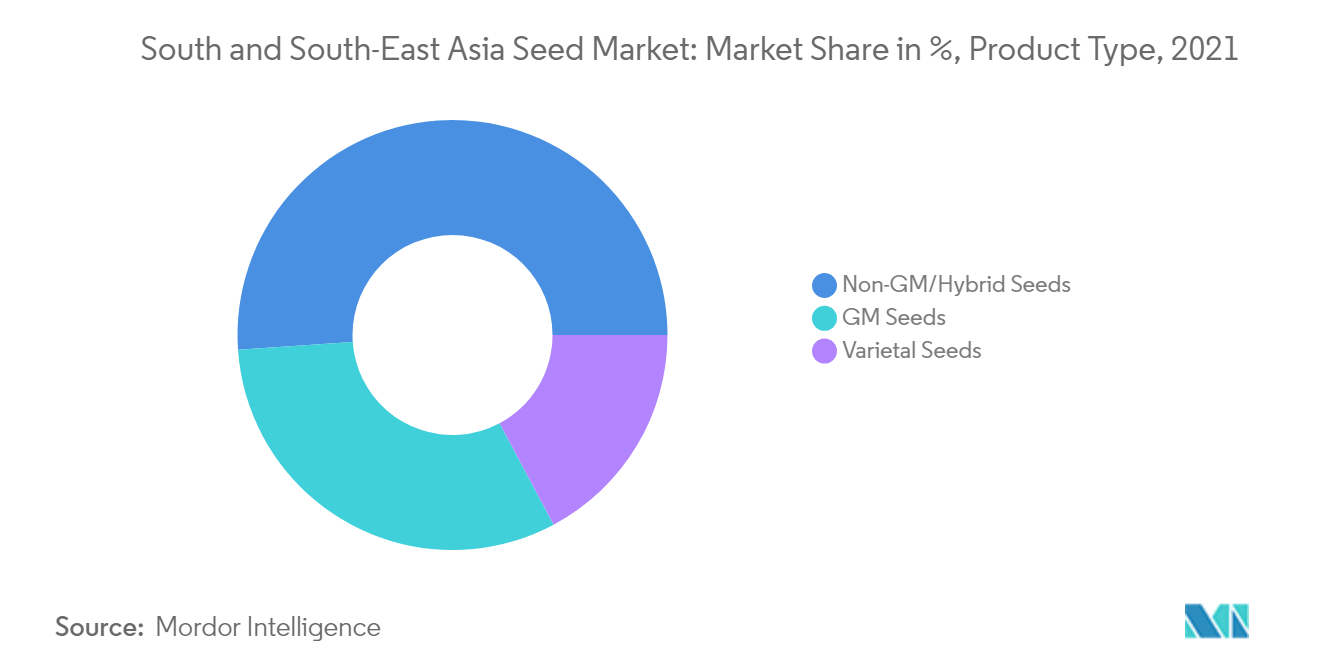South & South East Asia Seed Market Size

| Study Period | 2019 - 2029 |
| Base Year For Estimation | 2023 |
| Market Size (2024) | USD 8.09 Billion |
| Market Size (2029) | USD 10.35 Billion |
| CAGR (2024 - 2029) | 5.03 % |
| Market Concentration | Medium |
Major Players
*Disclaimer: Major Players sorted in no particular order |
South & South East Asia Seed Market Analysis
The South And Southeast Asia Seed Market size is estimated at USD 8.09 billion in 2024, and is expected to reach USD 10.35 billion by 2029, growing at a CAGR of 5.03% during the forecast period (2024-2029).
The production, certification, distribution, and cost of seeds, play a key role in developing the agricultural sector in South and Southeast Asian countries. International trade suffered due to slow or lack of transportation, labor shortages, and a contraction in the market for plants and seeds. Several factors, such as improvements in the agricultural sector, seed production, trade, and international agreements, along with the developments in seed technology, increased the momentum of the industry's growth. Six countries, namely India, Thailand, Indonesia, Vietnam, the Philippines, and Bangladesh, are considered seed hubs in Southeast Asia based on the concentration of production, breeding, and processing activities by index companies in these countries. The non-GM/hybrid seeds segment has dominated the market due to the increased demand for food over recent years. To meet this growing demand, crop yield enhancement has become a necessity. The major players in the market are Bayer Crop Science SE, Syngenta International AG, Corteva AgriScience, BASF SE, and Nuziveedu Seeds Ltd, among others.
South & South East Asia Seed Market Trends
Increasing Adoption of Hybrid Seeds and Government Support
The willingness and interest to grow hybrid crops are, to a large extent, governed by government legislation and policy in many of the countries studied. Pakistan is both a producer and importer of hybrid crops and products. The Pakistani seed sector is dependent on two key regulations, namely, the Seed Amendment Act 2015 and the Plant Breeders Rights Act 2018. In 2016, the Pakistan National Assembly adopted a Plant Breeders' Rights Act to encourage the development of new plant varieties and protect the rights of breeders of such varieties. The Act provides protection for new plant varieties while at the same time respecting the right of farmers to save, use, exchange, and sell farm-saved seeds. This ensures farmers get access to high-quality hybrid seeds alongside using ingeniously produced ones. The rising import of hybrid seeds is a direct impact of these measures. The National Assembly Standing Committee on National Food Security and Research banned the import of genetically modified (GM) seeds of maize owing to health and environmental issues in 2019. This may act as a driver for the use of hybrid seeds as an alternative to these GM seeds for keeping the yield constant.

Non-GM/Hybrid Seeds Segment Dominating the Market
In the South and Southeast Asian regions, the demand for food has increased exponentially over recent years. To meet this demand, crop yield enhancement has become a necessity for governments while maintaining safety standards. The Philippines is home to the International Rice Research Institute and is one of the most prolific users of hybrid rice seeds in the region to meet growing demand. The Green Revolution in India promoted the use of hybrid seeds in the country. The fast-growing population in the country has increased the demand for domestically produced hybrid seeds compatible with the climate conditions. Hybrid rice seeds imported to Pakistan are more expensive than those produced locally. The limited landholdings of farmers reduce their ability to purchase these hybrid seeds. The Agricultural Innovation Program launched by the government is expected to increase the adoption of hybrid maize seeds by farmers. This is expected to further increase the domestic hybrid seed production in the country. The use of hybrid seeds has been increasing over the years in the south and southeast Asian regions, with the increasing global demand for organic products and the need for enhanced crop yields in the region. This continued trend is expected to boost the market for hybrid-non-GMO seeds in the region.

South & South East Asia Seed Industry Overview
The South and Southeast Asian seed market is fragmented because of the presence of a large number of local players marketing certified seeds. However, there are segments within the market that are consolidated, such as maize and vegetables. The major players in the market are Bayer Crop Science SE, Syngenta International AG, Corteva AgriScience, BASF SE, and Nuziveedu Seeds Ltd, among others. Furthermore, increasing investments by prominent companies are further intensifying the growth of the seed market.
South & South East Asia Seed Market Leaders
-
Bayer Crop Science AG
-
Corteva Agriscience
-
Syngenta
-
BASF SE
-
Nuziveedu Seeds Ltd
*Disclaimer: Major Players sorted in no particular order

South & South East Asia Seed Market News
August 2023: Bayer AG has launched the herbicide-tolerant biotech corn Dekalb DK95R in Banggo village, Manggalewa district, Dompu Regency, West Nusa Tenggara, Indonesia.
June 2023: Rallis India has launched the Drishti project in collaboration with Tata Consultancy Services Limited. This innovative project aims to monitor hybrid seed production using the power of artificial intelligence. By harnessing these technologies, the project can generate predictive advisories on various crop conditions, soil moisture levels, and pest infestations.
June 2023: BASF, Syngenta, and Arisa have collaborated to establish the Wage Improvement in Seed Hybrids (WISH) initiative in India. This multi-stakeholder project aims to address child labor and promote compliance with minimum wage standards in the vegetable seed sector.
South & South East Asia Seed Market Report - Table of Contents
1. INTRODUCTION
- 1.1 Study Assumptions & Market Definition
- 1.2 Scope of the Study
2. RESEARCH METHODOLOGY
3. EXECUTIVE SUMMARY
4. MARKET DYNAMICS
- 4.1 Market Overview
- 4.2 Market Drivers
- 4.3 Market Restraints
-
4.4 Porter's Five Forces Analysis
- 4.4.1 Bargaining Power of Suppliers
- 4.4.2 Bargaining Power of Buyers
- 4.4.3 Threat of New Entrants
- 4.4.4 Threat of Substitute Products
- 4.4.5 Intensity of Competitive Rivalry
5. MARKET SEGMENTATION
-
5.1 Crop Type
- 5.1.1 Grains and Cereals
- 5.1.2 Pulses and Oilseeds
- 5.1.3 Cotton
- 5.1.4 Vegetables
- 5.1.5 Other Seeds
-
5.2 Product Type
- 5.2.1 Non-GM/Hybrid Seeds
- 5.2.2 GM Seeds
- 5.2.3 Varietal Seeds
- 5.2.4 Plant Growth Regulators
-
5.3 Geography
- 5.3.1 Bangladesh
- 5.3.2 Pakistan
- 5.3.3 India
- 5.3.4 Nepal
- 5.3.5 Vietnam
- 5.3.6 Indonesia
- 5.3.7 Thailand
- 5.3.8 Myanmar
- 5.3.9 Philippines
- 5.3.10 Rest of South and Southeast Asia
6. COMPETITIVE LANDSCAPE
- 6.1 Most Adopted Strategies
- 6.2 Market Share Analysis
-
6.3 Company Profiles
- 6.3.1 East-West Seed International Limited
- 6.3.2 Bayer Crop Science
- 6.3.3 Syngenta AG
- 6.3.4 Alamgir Seed Company
- 6.3.5 Rallis India Ltd
- 6.3.6 Advanta Seeds (UPL)
- 6.3.7 Nuziveedu Seeds Ltd
- 6.3.8 Kaveri Seeds Co. Ltd
- 6.3.9 Bioseed
- 6.3.10 Evogene Seeds
- *List Not Exhaustive
7. MARKET OPPORTUNITIES AND FUTURE TRENDS
8. IMPACT OF COVID-19 ON THE MARKET
** Subject To AvailablitySouth & South East Asia Seed Industry Segmentation
A seed is the ripened fertilized ovule of a flowering plant containing an embryo and is generally capable of germination to produce a new plant. For this report, seeds have been defined as seeds for sowing at the farmer level. In this report, market sizing has been done at the farmer's level. The report provides an in-depth analysis of various parameters of the seeds market. The South and Southeast Asian seeds market is segmented by crop type (grains and cereals, pulses and oilseeds, cotton, vegetables, and other seeds), product type (non-GM/hybrid seeds, GM seeds, varietal seeds, and plant growth regulators), and geography (Bangladesh, Pakistan, India, Nepal, Vietnam, Indonesia, Thailand, Myanmar, Malaysia, Philippines, and Rest of South and Southeast Asia). The report offers market size and forecasts for the seed industry in volume (Metric Ton) and in value (USD).
| Crop Type | Grains and Cereals |
| Pulses and Oilseeds | |
| Cotton | |
| Vegetables | |
| Other Seeds | |
| Product Type | Non-GM/Hybrid Seeds |
| GM Seeds | |
| Varietal Seeds | |
| Plant Growth Regulators | |
| Geography | Bangladesh |
| Pakistan | |
| India | |
| Nepal | |
| Vietnam | |
| Indonesia | |
| Thailand | |
| Myanmar | |
| Philippines | |
| Rest of South and Southeast Asia |
South & South East Asia Seed Market Research FAQs
How big is the South And Southeast Asia Seed Market?
The South And Southeast Asia Seed Market size is expected to reach USD 8.09 billion in 2024 and grow at a CAGR of 5.03% to reach USD 10.35 billion by 2029.
What is the current South And Southeast Asia Seed Market size?
In 2024, the South And Southeast Asia Seed Market size is expected to reach USD 8.09 billion.
Who are the key players in South And Southeast Asia Seed Market?
Bayer Crop Science AG, Corteva Agriscience, Syngenta, BASF SE and Nuziveedu Seeds Ltd are the major companies operating in the South And Southeast Asia Seed Market.
What years does this South And Southeast Asia Seed Market cover, and what was the market size in 2023?
In 2023, the South And Southeast Asia Seed Market size was estimated at USD 7.68 billion. The report covers the South And Southeast Asia Seed Market historical market size for years: 2019, 2020, 2021, 2022 and 2023. The report also forecasts the South And Southeast Asia Seed Market size for years: 2024, 2025, 2026, 2027, 2028 and 2029.
South and Southeast Asia Seed Industry Report
Statistics for the 2024 South and Southeast Asia Seed market share, size and revenue growth rate, created by Mordor Intelligence™ Industry Reports. South and Southeast Asia Seed analysis includes a market forecast outlook to 2029 and historical overview. Get a sample of this industry analysis as a free report PDF download.



